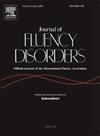在言语准备阶段对听觉线索的脑电图反应预测口吃严重程度和干预结果
IF 2.1
3区 医学
Q1 AUDIOLOGY & SPEECH-LANGUAGE PATHOLOGY
引用次数: 0
摘要
口吃是一种可变的语言障碍,其大脑机制尚不清楚。感觉运动脑回路是运动-语言控制的关键,包括对语言后果的预测和监测,与这种疾病有关。尽管取得了相当大的进步,但听觉神经回路是否与口吃的严重程度有关,以及对口吃者的干预是否会引起潜在的大脑变化,仍不清楚。我们采用脑电图(EEG),在一组口吃(PWS)的人,结合听觉探针来挖掘听觉皮层区域在口吃严重程度的相关性。参与者根据听觉提示发出灵活的语言(如描述图片)和非灵活的语言(如阅读音节)。重度口吃者的P200听觉诱发电位对听觉线索的反应更为明显,主要表现在图片任务中。有趣的是,虽然言语治疗干预导致P200电位的降低(尽管不显著),但这种降低与语言流畅性的提高有轻微的相关性。此外,区分提示音频率(400 Hz vs 800 Hz)的脑电图反应模式也能预测口吃的严重程度,这表明细粒度听觉皮层加工参与了言语准备和口吃。综上所述,本研究证实了外部声音的听觉加工与言语准备过程中口吃的机制之间的关系,并强调了在相对生态条件下,使用图片描述任务来研究听觉诱发电位与口吃严重程度之间的关系的优势。本文章由计算机程序翻译,如有差异,请以英文原文为准。
EEG responses to auditory cues during speech preparation predict stuttering severity and intervention outcome
Stuttering is a variable speech disorder whose brain mechanisms remain unknown. Sensorimotor brain circuits, critical in motor-speech control, including the prediction and monitoring of speech consequences, have been linked to the disorder. Despite considerable advances, it remains unclear whether auditory neural circuits relate to stuttering severity, and whether interventions to persons who stutter can induce underlying brain changes. We employed electroencephalography (EEG), in a group of persons who stutter (PWS), in combination with auditory probes to tap onto the relevance of auditory cortical regions in stuttering severity. Participants produced flexible speech (i.e., describing pictures) and non-flexible speech (i.e., reading syllables), following an auditory cue. More pronounced P200 auditory evoked potentials in response to the auditory cues were observed in participants with more severe stuttering, mainly in the picture task. Interestingly, while speech therapy intervention led to a reduction (albeit non-significant) of the P200 potential, this reduction was marginally correlated to speech fluency improvements. Moreover, EEG response patterns discriminative of cue tone frequency (400 Hz versus 800 Hz) were also predictive of stuttering severity, suggesting the involvement of fine-grained auditory cortical processing in speech preparation and stuttering. Overall, this study confirms a relationship between auditory processing of external sounds and the mechanisms of stuttering during the preparation to speak and highlights the advantage of a picture description task to investigate the relationship between auditory evoked potentials and stuttering severity under relatively ecological conditions.
求助全文
通过发布文献求助,成功后即可免费获取论文全文。
去求助
来源期刊

Journal of Fluency Disorders
AUDIOLOGY & SPEECH-LANGUAGE PATHOLOGY-REHABILITATION
CiteScore
3.70
自引率
14.30%
发文量
23
审稿时长
>12 weeks
期刊介绍:
Journal of Fluency Disorders provides comprehensive coverage of clinical, experimental, and theoretical aspects of stuttering, including the latest remediation techniques. As the official journal of the International Fluency Association, the journal features full-length research and clinical reports; methodological, theoretical and philosophical articles; reviews; short communications and much more – all readily accessible and tailored to the needs of the professional.
 求助内容:
求助内容: 应助结果提醒方式:
应助结果提醒方式:


